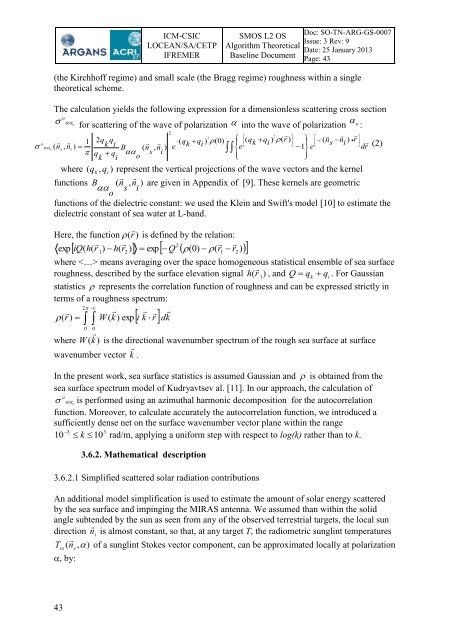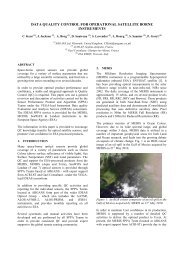SMOS L2 OS ATBD - ARGANS
SMOS L2 OS ATBD - ARGANS
SMOS L2 OS ATBD - ARGANS
You also want an ePaper? Increase the reach of your titles
YUMPU automatically turns print PDFs into web optimized ePapers that Google loves.
43<br />
ICM-CSIC<br />
LOCEAN/SA/CETP<br />
IFREMER<br />
<strong>SM<strong>OS</strong></strong> <strong>L2</strong> <strong>OS</strong><br />
Algorithm Theoretical<br />
Baseline Document<br />
Doc: SO-TN-ARG-GS-0007<br />
Issue: 3 Rev: 9<br />
Date: 25 January 2013<br />
Page: 43<br />
(the Kirchhoff regime) and small scale (the Bragg regime) roughness within a single<br />
theoretical scheme.<br />
The calculation yields the following expression for a dimensionless scattering cross section<br />
o<br />
o<br />
for scattering of the wave of polarization into the wave of polarization<br />
o :<br />
2<br />
<br />
2<br />
<br />
2 <br />
1 2q<br />
q<br />
q q<br />
qk<br />
qi<br />
r<br />
k i (<br />
n n<br />
B n n e k <br />
<br />
i ) (<br />
0)<br />
<br />
(<br />
) (<br />
) <br />
<br />
<br />
<br />
<br />
( s , i ) ( , )<br />
e<br />
e<br />
q q s i<br />
<br />
1<br />
<br />
k i o<br />
<br />
<br />
<br />
( ns<br />
ni<br />
) r<br />
<br />
<br />
dr<br />
i<br />
o<br />
(2)<br />
o<br />
where ( q k , qi<br />
) represent the vertical projections of the wave vectors and the kernel<br />
<br />
functions B ( n , n ) are given in Appendix of [9]. These kernels are geometric<br />
s i<br />
o<br />
functions of the dielectric constant: we used the Klein and Swift's model [10] to estimate the<br />
dielectric constant of sea water at L-band.<br />
Here, the function (r )<br />
<br />
is defined by the relation:<br />
<br />
2 <br />
iQ(<br />
h(<br />
r ) h(<br />
r ) exp Q ( 0)<br />
(<br />
r r )<br />
<br />
<br />
exp 1 2<br />
1 2<br />
where means averaging over the space homogeneous statistical ensemble of sea surface<br />
roughness, described by the surface elevation signal h( r 1)<br />
<br />
, and Q qk<br />
qi<br />
. For Gaussian<br />
statistics represents the correlation function of roughness and can be expressed strictly in<br />
terms of a roughness spectrum:<br />
2<br />
<br />
<br />
(<br />
r)<br />
W ( k ) exp i k r dk<br />
<br />
0 0<br />
<br />
where W (k )<br />
is the directional wavenumber spectrum of the rough sea surface at surface<br />
wavenumber vector k .<br />
In the present work, sea surface statistics is assumed Gaussian and is obtained from the<br />
sea surface spectrum model of Kudryavtsev al. [11]. In our approach, the calculation of<br />
o<br />
o<br />
is performed using an azimuthal harmonic decomposition for the autocorrelation<br />
function. Moreover, to calculate accurately the autocorrelation function, we introduced a<br />
sufficiently dense net on the surface wavenumber vector plane within the range<br />
3<br />
3<br />
10 k 10<br />
rad/m, applying a uniform step with respect to log(k) rather than to k.<br />
3.6.2. Mathematical description<br />
3.6.2.1 Simplified scattered solar radiation contributions<br />
An additional model simplification is used to estimate the amount of solar energy scattered<br />
by the sea surface and impinging the MIRAS antenna. We assumed than within the solid<br />
angle subtended by the sun as seen from any of the observed terrestrial targets, the local sun<br />
direction ni is almost constant, so that, at any target T, the radiometric sunglint temperatures<br />
T ( , )<br />
<br />
of a sunglint Stokes vector component, can be approximated locally at polarization<br />
ss ns<br />
, by:



